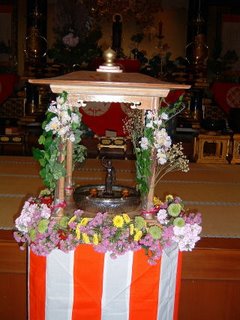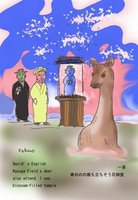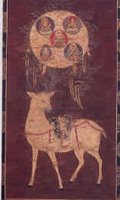:::::::::::::::::::::::::::::::::::::::::::::::::::::::::::::::::::::::::::::::::::::::::::::::::::::
Flower Hall, flower pavillion, blossom hall
hana midoo 花御堂
April 8:
Kanbutsu-e 潅仏会: Buddha's Birthday
This is also called the Hana Matsuri 花祭り or Flower Festival (Blossom Festival). A small hall called the hanamido is set up at the Buddhist temples and decorated with colorful flowers. Small statues of the child Buddha are decorated with flowers and hydrangea tea is poured over the statue by worshippers.
The tea is prepared in considerable quantity and distributed to festival visitors.
hanamidoo, hanamidō, hanamidou
The Small Flower Hall at the Temple Toodaiji 奈良の東大寺is especially famous. With the background of the Big Buddha (daibutsu) in Nara, the small statue of the Baby Buddha just born is really a contrast.

The newborn Gautama holds one hand to the sky and one hand to the earth.
Children pour sweet water over the statue and drink hydrangea tea, "sweet tee" (amacha 甘茶).
MORE KIGO related to this event
Buddha's Birthday : Busshoo-e 仏生会
:::::::::::::::::::::::::::::::::::::::::::::::::::::::::::::::::::::::::::::::::::::::::::::::::::::

More Photos from the Celebratrion in 2006
Click HERE to see more photos of this small hall.
:::::::::::::::::::::::::::::::::::::::::::::::::::::::::::::::::::::::::::::::::::::::::::::::::::::
From the Tri-State/Denver Buddhist Temple
http://www.tsdbt.org/Services/special.html
Hanamatsuri (Flower Festival)
Kanbutsu-E (Bathe Buddha Gathering)
This is the day we celebrate the birth of Siddhartha Gautama who became enlightened as Shakyamuni Buddha.
According to legend, Queen Maya dreamt of a white elephant entering her body; a wise man interpreted this event as the impending birth of Prince Siddhartha. In keeping with the custom of the time, Queen Maya prepared to return to her parent's home to give birth to her baby.
Along the way, she stopped for a rest in Lumbini Garden. As she reached to pluck the Asoka blossoms, her little son was born.
Immediately, the child rose to his feet and walked seven steps. He raised his right hand toward the sky, his left hand reached downward, and he proclaimed,
"Above heaven and below heaven, I alone am the World Honored One."
Then a very gentle and sweet rain fell on the baby and bathed him.
This legendary story is not taken literally but used to describe the significance of an extraordinary person. For instance, the seven steps taken in the story illuminate the step beyond the sixth realism of suffering or human bondage; the Buddha took that extra step to
Enlightenment.
With the warm spring weather bringing out fresh buds and new life, we strive to take the seventh step by opening our eyes and hearts to the significance of Hanamatsuri.
The Hanamido, or miniature altar of flowers, symbolizes the beautiful Lumbini Garden.
The pouring of the sweet tea (Kanbutsu-E) on the statue of the baby Buddha represents the gentle rain which fell that day in Lumbini."
:::::::::::::::::::::::::::::::::::::::::::::::::::::::::::::::::::::::::::::::::::::::::::::::::::::
More information about BUDDHA'S BIRTHDAY CELEBRATION, busshoo-e !
It falls in the beginning of the Cherry Blossom Season.
:::::::::::::::::::::::::::::::::::::::::::::::::::::::::::::::::::::::::::::::::::::::::::::::::::::
...................... HAIKU
Buddha's Birthday Celebrations, Busshoo-e 仏生会
kigo for Late Spring.
春日のの鹿も立ちそう花御堂
kasuga no no shika mo tachisoo hana midoo
Kasuga Field's deer
also attend, I see...
blossom-filled temple
Issa
Tr. David Lanoue

The deer is a servant of the Shinto-shrine, Kasuga Shrine.
Hanami-dou (blossom-filled temple) is Buddha’s holy house.
Judging from Christian religious point of view they are both heathen.
According to Western commonsense, it seems to be that an Arab’s camel visits a synagogue.
神鹿祝う仏の誕生
shin-roku iwau hotoke no tanjoo
Shinto’s deer celebrates
the birth of Buddha.
Haiga by Nakamura Sakuo
Revised Translation by David Lanoue
Kasuga Field's deer
also attend, I see...
Buddha's birthday flowers
Here is a look at the Kasuga Shrine Mandala 春日曼荼羅, with the Sacred Deer:

http://www.hgeo.h.kyoto-u.ac.jp/soramitsu/kasuga_mandala.html
Read more:
Kasuga Shrine Mandala and the Deer
... ... ... ... ...
kasugano ya dagashi ni majiru shika no kuso
Kasuga Field--
penny candy mingles
with deer poop
Shinji Ogawa explains, "The Kasugano (Kasuga Plain or Field), famous for its deer, is located east of Kohuku Temple and south of Toodai Temple." The temple is filled with flowers in honor of Gautama Buddha's birthday, celebrated on the Eighth Day of Fourth Month. Here, the deer seem to be honoring Buddha along with the human visitors.
へぼ蜂が孔雀気どりや花御堂
hebo-bachi ga kujaku kidori ya hana midô
the ordinary bee
struts like a peacock...
blossom-filled temple
虻蜂の大吉日や花御堂
abu hachi no ôkichi nichi ya hana midô
horseflies' and bees'
big lucky day...
blossom-filled temple
蟻の道はや付にけり花御堂
ari no michi haya tsuki ni keri hana midô
the ants rush
to make a road...
blossom-filled temple
More haiku by Issa about the Flower Hall
More haiku by Issa about the Birthday of Buddha
:::::::::::::::::::::::::::::::::::::::::::::::::::::::::::::::::::::::::::::::::::::::::::::::::::::
muyuuge no kokage wa izuko busshoo-e
Sugita Hisajo
...pray tell where...the shady asoka
...............blooms...on Buddha's birthday
Tr. Eiko Yachimoto and Debi Bender. World Haiku Review
:::::::::::::::::::::::::::::::::::::::::::::::::::::::::::::::::::::::::::::::::::::::::::::::::::::
- - - - - MATSUO BASHO - - - - -
潅仏の日に生れあふ鹿の子かな
灌仏の日に生れあふ鹿の子 哉
くわんぶつのひにうまれあふかのこかな / (かんぶつのひに うまれあう かのこかな)
kanbutsu no hi ni umare-au ka no ko kana
Buddha’s birthday:
on this day is born
a little fawn
Tr. Barnhill
- quote
happening to be born
on Buddha's birthday
a baby deer!
"Nara's deer are considered the messengers of the main deity of the Kasuga Shrine, Takemigatsuchi, who came riding a deer all the way from Kashima in present-day Ibaraki Prefecture to Nara. At the same time, they remind of the Deer Park in Benares, where the Buddha gave his first sermon. They therefore have both a Shinto and Buddhist meaning and admirably fit the religious multiplex of Kofukuji Temple and Kasuga Taisha shrine which originally stood here.
There are about 1,000 of them and they have always been a protected species. In the past, people who killed one of these animals received the death sentence by being buried alive; now offenders are punished in a somewhat lighter manner. It seems, unfortunately, that this
protection has rather spoiled the deer, who have lost their natural meekness and have become positively aggressive. They have been observed to snatch and consume handbags of innocent visitors.
At night the deer are gathered in an enclosure lying to the side of the path leading to the Kasuga Shrine. A trumpet signal calls them together. To prevent them from getting into fights in rut time, their antlers are cut every year from the middle of October to early November. This is done in a special ceremony on Sundays and holidays in that period and attracts many spectators.
Nara's deer inspired Basho also to other haiku, for example when he came across a baby deer born on the very day the Buddha's Birthday was celebrated (April 8 in the modern calendar, the Kanbutsu Festival, also called Flower Festival)."
tr. and comments by Ad G. Blankestijn:
- Quoted from Happy Haiku Forum
Oi no Kobumi 笈の小文 in Yamato 大和路
On the 8th day of the 4th lunar month 四月八日
After leaving Yoshino, Basho was able to observe the birth of a baby deer.
. Matsuo Basho 松尾芭蕉 - Archives of the WKD .
:::::::::::::::::::::::::::::::::::::::::::::::::::::::::::::::::::::::::::::::::::::::::::::::::::::::::::::::::
Buddha Jayanthi
Ah! Bodhisattvas move on,
great seer ants
buddha jayanthi
aho! bodhisattvaascharanthi
pipiliko mahaa rishaya:
[Sanskrit]
Narayanan Raghunathan, August 2006
Buddha, Shakyamuni, Shaka and Haiku INDIA SAIJIKI
:::::::::::::::::::::::::::::::::::::::::::::::::::::::::::::::::::::::::::::::::::::::::::::::::::
kigo for early summer
uzuki yooka 卯月八日 (うづきようか) eighth day of the uzuki month
tentoobana 天頭花(てんとうばな)
tendoobana 天頭花(てんどうばな)
..... tentobana てんと花(てんとばな / 天道花)
"flowers along the heavenly road"
Uzuki - 6 May – 5 Jun (May) Deutzia Month
This is the day of the celebrations of Buddha's birthday (kanbutsu-e) in the old lunar calendar.
Rural communities celebrated this as the day welcoming the "god of the mountains" back to the fields. Farmers would pick wild flowers and deutzia blossoms, make a wrath out of them put on a high stick and decorate it to please the deity. It was the day for a new beginning in the farmer's life circle. There were many other rituals on this day too.
てんどうばな tendoobana, u no hana
. Deutzia blossoms (u no hana)
:::::::::::::::::::::::::::::::::::::::::::::::::::::::::::::::::::::::::::::::::::::::::::::::::::
Kigo for April, Late Spring
[ . BACK to WORLDKIGO . TOP . ]
[ . BACK to DARUMA MUSEUM TOP . ]
:::::::::::::::::::::::::::::::::::::::::::::::::::::::::::::::::::::::::::::::::::::::::::::::::::::








7 comments:
I especially like the third line of the haiku. It's a beautiful
poetic gesture.
C. from America
.
on the lucky Eighth Day
of Fourth Month...
a mountain cuckoo
kichi nichi no uzuki yooka mo kankodori
吉日の卯月八日もかんこ鳥
by Issa, 1814
On the Eighth Day of Fourth Month Gautama Buddha's birthday is celebrated.
In one text, this haiku has the prescript: "In the hut." In another, Issa prefaces it with: "Relaxing at the window" or "Quiet window."
Tr. David Lanoue
http://cat.xula.edu/issa/
Kobayashi Issa
かん仏やふくら雀も親連れて
kanbutsu ya fukura-suzume mo oya tsurete
bathing baby Buddha --
plump young sparrows, too
bring along parents
This early summer hokku was written in the 4th month (May) in 1806, when Issa was living in Edo. The hokku evokes a ceremony called kambutsu-e (灌仏会) or Bathing Baby Buddha at a temple on 4/8, the traditional birthday of Shakyamuni Buddha in Japan and most of East Asia. On that day almost all temples put up a miniature hall called a flower hall in front of or on the porch of the main hall, and in it they place a small statue of a usually chubby baby Buddha with one arm pointing toward heaven and the other toward earth, thus signifying the whole universe. Flowers are placed on and in this miniature hall to represent the flowers and flowering trees of Lumbini Grove, where tradition says the Buddha was born. The statue of baby Buddha stands on a small platform in the middle of a wide bowl of sweet tea made from hydrangea leaves, tea which represents the heavenly elixir of immortality poured on the baby Buddha by nine dragons soon after his birth as well as the water used to wash all babies soon after birth. Visitors to temples, including many children, use a small dipper to pour the tea in the wide bowl over the statue of baby Buddha, symbolically washing him as if he were a newborn baby and thereby wishing him happy birthday.
In the hokku the area in front of the small flower-covered hall containing the statue of baby Buddha is filled with visitors to the temple waiting to get a chance to stand near the statue and pour sweet tea over it. The visitors include both human and sparrow families. The plump baby sparrows, like the human children around them, no doubt move along at a quick pace, followed by their parents, who struggle to keep up with them. Probably the young sparrows are moving with the crowd, though to Issa they look full of intention, and when they reach the statue of the Buddha they will no doubt wash the baby Buddha not with a dipper but by splashing around and having fun in the sweet tea bowl below the baby Buddha's statue. Issa is fascinated by the similarity between human children and young sparrows. On this special day it's kids of all kinds who lead their parents and show them how it's done.
Chris Drake
Kobayashi Issa
灌仏の御指の先や暮の月
kanbutsu no o-yubi no saki ya kure no tsuki
on the tip
of birthday Buddha's finger
setting moon
Tr. David lanoue
.
Kobayashi Issa
花御堂月も上らせ給ひけり
hanamidoo tsuki mo noborese tamai keri
Buddha amid birthday flowers--
even the moon
deigns to rise
The moon, too, seems to honor the Buddha on his special day.
Tr. David Lanoue
.
Kobayalshi Issa
御指に銭が一文たん生仏
on-yubi ni zeni ga ichi mon tanjoo butsu
on his finger
one penny...
Buddha's birthday
On the Eighth Day of Fourth Month Gautama Buddha's birthday is celebrated. The mon was the basic currency of Issa's time. It took the form of a coin with a hole in its middle so that it could be strung on a string. In Issa's day six mon could pay for a bowl of rice.
.
David Lanoue
.
誕生仏 Tanjobutsu
.
I really enjoy reading about Shakyamuni Buddha . I truly appreciated your article. Please continue to write.
Post a Comment